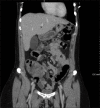Detection of coexisting toxigenic Clostridium difficile and nontyphoidal Salmonella in a healthcare worker with diarrhea: A therapeutic dilemma
- PMID: 31548964
- PMCID: PMC6753814
- DOI: 10.4103/jfmpc.jfmpc_227_19
Detection of coexisting toxigenic Clostridium difficile and nontyphoidal Salmonella in a healthcare worker with diarrhea: A therapeutic dilemma
Abstract
Introduction: Clostridium difficile infection (CDI) and nontyphoidal Salmonella infection (NSI) have similar clinical manifestations and are seldom seen simultaneously. The decision-making in terms of antibiotic therapy becomes difficult when both the pathogens are isolated from the same patient.
Case presentation: We describe a case of Clostridium difficile (CD) enterocolitis in a healthcare provider who concomitantly tested positive for nontyphoidal Salmonella.
Discussion: To the best of our knowledge after extensive literature review (English), this is only the fourth report highlighting this association.
Conclusion: Although Salmonella is not a risk factor for CDI, it can cause intestinal inflammation and alteration in the intestinal flora. When two pathogens are isolated from the same patient, it is tempting to treat both with antibiotics as highlighted. When it involves healthcare workers, there is no difference in guidelines and should not be prescribed antibiotics with intent of reducing secondary transmission.
Keywords: Antibiotics; Clostridium difficile; diarrhea; healthcare worker; nontyphoidal Salmonella.
Conflict of interest statement
There are no conflicts of interest.
Figures


References
-
- McDonald LC, Gerding DN, Johnson S, Bakken JS, Carroll KC, Coffin SE, et al. Clinical practice guidelines for Clostridium difficile infection in adults and children: 2017 update by the Infectious Diseases Society of America (IDSA) and Society for Healthcare Epidemiology of America (SHEA) Clin Infect Dis. 2018;66:987–94. - PubMed
-
- Voetsch AC, Van Gilder TJ, Angulo FJ, Farley MM, Shallow S, Marcus R, et al. FoodNet estimate of the burden of illness caused by nontyphoidal Salmonella infections in the United States. Clin Infect Dis. 2004;38(Suppl 3):S127–34. - PubMed
-
- Chalker RB, Blaser MJ. A review of human salmonellosis: III. Magnitude of Salmonella infection in the United States. Rev Infect Dis. 1988;10:111–24. - PubMed

